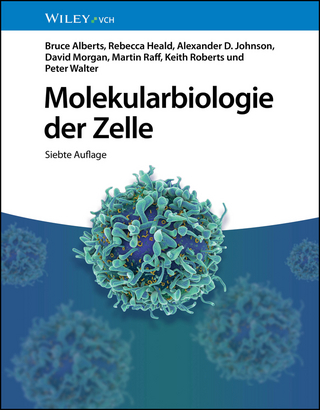
Essential Biochemistry, International Adaptation
John Wiley & Sons Inc (Verlag)
978-1-394-22327-5 (ISBN)
This international adaptation contains up-to-date coverage of topics, including Ramachandran diagrams, lysozymes, steroid hormones, and ionophores. It also offers integrated coverage of SARS-CoV-2 and the impacts of COVID-19, relating it to the importance of an interdisciplinary response to a global pandemic. By focusing on strengthening the organization of the content as well as updating the end-of-chapter problems, this edition presents a brand-new experience to the reader.
CHARLOTTE PRATT received a B.S. in biology from the University of Notre Dame and a Ph.D. in biochemistry from Duke University. She is a protein chemist who has conducted research in blood coagulation and inflammation at the University of North Carolina at Chapel Hill. She is currently Associate Professor in the Biology Department at Seattle Pacific University. Her interests include molecular evolution, enzyme action, and the relationship between metabolic processes and disease. She has written numerous research and review articles, has worked as a textbook editor, and is a co-author, with Donald Voet and Judith G. Voet, of Fundamentals of Biochemistry, published by John Wiley & Sons, Inc. KATHLEEN CORNELY holds a B.S. in chemistry from Bowling Green (Ohio) State University, an M.S. in biochemistry from Indiana University, and a Ph.D. in nutritional biochemistry from Cornell University. She is currently the Robert H. Walsh '39 Endowed Professor in Chemistry and Biochemistry at Providence College, where she has focused on expanding the use of case studies and guided inquiry across a broad spectrum of classes. Her interest in active pedagogy has led to her involvement in national programs including Project Kaleidoscope, the POGIL Project, and the Howard Hughes Medical Institute SEA PHAGES program, which has also fueled her current experimental research in phage genomics. She has been a member of the editorial board of Biochemistry and Molecular Biology Education and has served for several years as coordinator of the undergraduate poster competition at the annual meeting of the American Society for Biochemistry and Molecular Biology.
Part 1 FOUNDATIONS
1 The Chemical Basis of Life
1.1 What Is Biochemistry?
1.2 The Origin of Cells
1.3 Biological Molecules
1.4 Energy and Metabolism
2 Aqueous Chemistry
2.1 Water Molecules and Hydrogen Bonds
2.2 The Hydrophobic Effect
2.3 Acid–Base Chemistry
2.4 Tools and Techniques: Buffers
2.5 Clinical Connection: Physiological Buffers
Part 2 MOLECULAR STRUCTURE AND FUNCTION
3 Nucleic Acid Structure and Function
3.1 Nitrogenous Bases
3.2 Nucleic Acid Structure
3.3 The Central Dogma
3.4 Genomics
4 Amino Acid and Protein Structure
4.1 Amino Acids, the Building Blocks of Proteins
4.2 Secondary Structure: The Conformation of the Peptide Group
4.3 Tertiary Structure and Protein Stability
4.4 Quaternary Structure
4.5 Clinical Connection: Protein Misfolding and Disease
4.6 Tools and Techniques: Analyzing Protein Structure
5 Protein Function
5.1 Myoglobin and Hemoglobin: Oxygen-Binding Proteins
5.2 Clinical Connection: Hemoglobin Variants
5.3 Structural Proteins
5.4 Motor Proteins
5.5 Antibodies
6 Enzymes: Classification and Catalysis
6.1 What Is an Enzyme?
6.2 Chemical Catalytic Mechanisms
6.3 Unique Properties of Enzyme Catalysts
6.4 Chymotrypsin in Context
6.5 Clinical Connection: Blood Coagulation
7 Enzyme Kinetics and Inhibition
7.1 Introduction to Enzyme Kinetics
7.2 The Michaelis–Menten Equation for an Enzyme-Catalyzed Reaction
7.3 Enzyme Inhibition
7.4 Clinical Connection: Drug Development
8 Lipids and Biological Membranes
8.1 Lipids
8.2 The Lipid Bilayer
8.3 Membrane Proteins
8.4 The Fluid Mosaic Model
9 Membrane Transport
9.1 The Thermodynamics of Membrane Transport
9.2 Passive Transport
9.3 Active Transport
9.4 Membrane Fusion
10 Signaling
10.1 General Features of Signaling Pathways
10.2 G Protein Signaling Pathways
10.3 Receptor Tyrosine Kinases
10.4 Lipid Hormone Signaling
11 Carbohydrates
11.1 Monosaccharides
11.2 Disaccharides, Oligosaccharides, and Polysaccharides
11.3 Glycoconjugates: Glycoproteins, Glycolipids, and Proteoglycans
11.4 Clinical Connection: Glucose and Diabetes Mellitus
Part 3 METABOLISM
12 Metabolism and Bioenergetics
12.1 Food and Fuel
12.2 Free Energy Changes in Metabolic Reactions
12.3 Metabolic Pathways
13 Carbohydrate Metabolism
13.1 Glycolysis
13.2 Gluconeogenesis
13.3 Glycogen Synthesis and Degradation
13.4 The Pentose Phosphate Pathway
13.5 Clinical Connection: Disorders of Carbohydrate Metabolism
14 The Citric Acid Cycle
14.1 The Pyruvate Dehydrogenase Reaction
14.2 The Eight Reactions of the Citric Acid Cycle
14.3 Thermodynamics of the Citric Acid Cycle
14.4 Anabolic and Catabolic Functions of the Citric Acid Cycle
15 Oxidative Phosphorylation
15.1 The Thermodynamics of Oxidation-Reduction Reactions
15.2 Mitochondrial Electron Transport
15.3 ATP Synthase
15.4 Chemiosmosis
16 Photosynthesis
16.1 Photosynthesis: An Overview
16.2 The Light Reactions
16.3 Carbon Fixation
17 Lipid Metabolism
17.1 Lipid Digestion and Transport
17.2 Fatty Acid Oxidation
17.3 Fatty Acid Synthesis
17.4 Synthesis of Other Lipids
18 Nitrogen Metabolism
18.1 Nitrogen Fixation and Assimilation
18.2 Amino Acid Biosynthesis
18.3 Amino Acid Catabolism
18.4 Excretion of Excess Nitrogen: The Urea Cycle
18.5 Nucleotide Metabolism
19 Regulation of Mammalian Fuel Metabolism
19.1 Integration of Fuel Metabolism
19.2 Hormonal Control of Fuel Metabolism
19.3 Disorders of Fuel Metabolism
19.4 Clinical Connection: Cancer Metabolism
Part 4 GENETIC INFORMATION
20 DNA Replication and Repair
20.1 DNA Packaging: Nucleosome and Chromatin
20.2 The DNA Replication Machinery
20.3 Telomeres
20.4 DNA Damage and Repair
20.5 Clinical Connection: Cancer as a Genetic Disease
20.6 Tools and Techniques: Manipulating DNA
21 Transcription and RNA Processing
21.1 Initiating Transcription
21.2 RNA Polymerase
21.3 RNA Processing
22 Protein Synthesis
22.1 tRNA and the Genetic Code
22.2 Ribosome Structure
22.3 Translation
22.4 Post-Translational Modifications
GLOSSARY
ODD-NUMBERED SOLUTIONS
INDEX
| Erscheinungsdatum | 05.04.2024 |
|---|---|
| Verlagsort | New York |
| Sprache | englisch |
| Themenwelt | Naturwissenschaften ► Biologie ► Biochemie |
| Naturwissenschaften ► Chemie | |
| ISBN-10 | 1-394-22327-7 / 1394223277 |
| ISBN-13 | 978-1-394-22327-5 / 9781394223275 |
| Zustand | Neuware |
| Haben Sie eine Frage zum Produkt? |
aus dem Bereich


